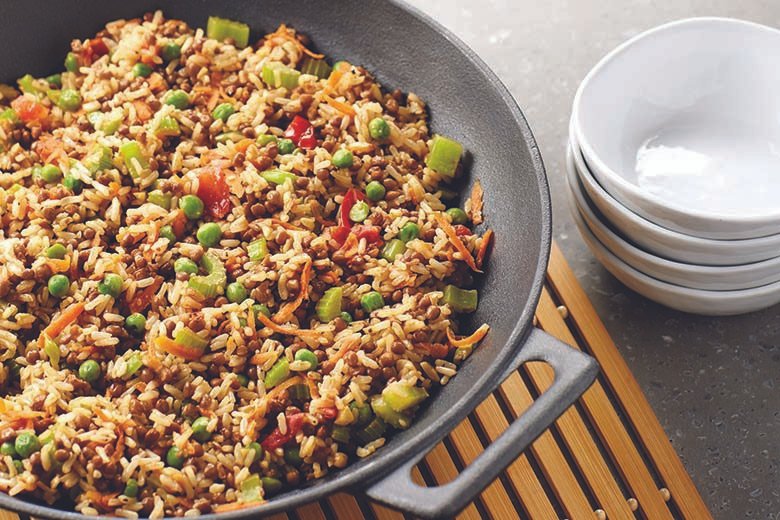As a lover of Asian cuisine, I am always on the lookout for the perfect rice to use in my homemade fried rice dishes.
Whether I’m craving the fragrant and delicate Jasmine Rice or the nutty and flavorful Basmati Rice, each type brings its own unique twist to this classic dish.
From Sticky Rice to Brown Rice, Sushi Rice to Glutinous Rice, there is a world of options to explore. Join me as we dive into the top 10 best types of rice for Asian fried rice, and discover the perfect grain to elevate your next meal.

Jasmine Rice
If you want your Asian fried rice to have a fragrant and fluffy texture, you should use jasmine rice. I love using jasmine rice for my fried rice dishes because it adds a wonderful aroma and a light, delicate flavor.
The grains of jasmine rice are long, slender, and slightly sticky, which helps to create that classic fried rice texture. When cooked, jasmine rice becomes fluffy and separates easily, making it perfect for absorbing all the flavors of the dish. It also has a slightly sweet taste, which pairs well with the savory ingredients commonly used in fried rice.
Overall, jasmine rice adds a touch of elegance to any Asian fried rice dish and elevates its taste to another level.
Basmati Rice
Cooking basmati rice perfectly requires rinsing it thoroughly and using the right water-to-rice ratio.
I love cooking basmati rice because of its long grains and delicate aroma.
To start, I rinse the rice under cold water until the water runs clear. This helps remove any excess starch and prevents the rice from becoming sticky.
Next, I add the rinsed rice to a pot and add water using a 1:1.5 ratio (one cup of rice to one and a half cups of water).
I bring it to a boil, then reduce the heat to low, cover the pot, and let it simmer for about 15-20 minutes, or until the rice is tender and the water is absorbed.
The result is fluffy, fragrant basmati rice that pairs perfectly with any Asian dish.
Sticky Rice
To make sticky rice, all you need is a bamboo steamer and glutinous rice. It’s one of my favorite types of rice to cook because of its unique texture and versatility.
The bamboo steamer helps to evenly cook the rice, allowing it to become soft and sticky. I love the way it clumps together, making it perfect for rolling into bite-sized balls or serving alongside flavorful dishes.
Glutinous rice has a natural sweetness that pairs well with both savory and sweet flavors. It’s commonly used in traditional Asian desserts like mango sticky rice or as a base for savory dishes like Thai sticky rice with grilled chicken.
Overall, sticky rice is a staple in my kitchen and a must-try for any rice lover.
Brown Rice
You should try incorporating brown rice into your meals for a healthier alternative to white rice. Brown rice is a whole grain that is packed with nutrients and fiber. It has a nutty flavor and a chewy texture that adds a delicious element to any dish.
I personally love using brown rice in my stir-fries and fried rice recipes. Not only does it provide a satisfying and filling base, but it also helps to stabilize blood sugar levels and promote better digestion.
Brown rice is also rich in antioxidants, vitamins, and minerals, making it a great choice for overall health and well-being.
Sushi Rice
When making sushi, it’s important to use short-grain rice for its stickiness and ability to hold its shape. I love using sushi rice because it creates the perfect texture and taste for my sushi rolls.
The short-grain rice has a higher starch content, which gives it that sticky consistency that is essential for rolling sushi. It also holds its shape well, ensuring that each sushi piece maintains its form.
The grains of sushi rice are slightly plump and tender, making it a delight to eat. Its mild flavor complements the other ingredients in the sushi roll, allowing them to shine.
Sushi rice is truly a key component in creating delicious and authentic sushi that everyone can enjoy.
Arborio Rice
Arborio rice is commonly used in risotto due to its high starch content, which creates a creamy and velvety texture. The grains are short and plump, allowing them to absorb the flavors of the broth and other ingredients. As I cook the rice, I can already see the starches being released, creating a thick and creamy sauce that coats each grain.
The texture is absolutely divine, with a slight chewiness that adds to the overall satisfaction of the dish. Arborio rice is truly a game-changer when it comes to risotto, elevating it to a whole new level of richness and indulgence.
Glutinous Rice
Glutinous rice, also known as sticky rice, is a staple in many Asian cuisines. I absolutely love using glutinous rice for my favorite dishes like mango sticky rice or sticky rice with Chinese sausage.
The texture of this rice is incredibly unique and it adds a wonderful chewiness to any dish it’s used in. One of the reasons why it’s so sticky is because of its high amylopectin content, which gives it that characteristic glue-like consistency.
Glutinous rice is perfect for making sushi rolls, dumplings, or even steamed desserts. It’s incredibly versatile and can be used in both savory and sweet dishes. When cooked, it has a slightly sweet flavor that pairs well with a variety of ingredients.
Overall, glutinous rice is a must-have in any Asian kitchen.
Calrose Rice
Calrose rice, also known as medium-grain rice, is a popular choice for dishes like sushi or rice bowls due to its sticky texture and ability to absorb flavors.
I love using Calrose rice in my homemade sushi rolls because it holds together well and adds a nice chewy texture.
When I make rice bowls, Calrose rice is my go-to because it soaks up all the delicious sauces and flavors from the toppings. Its sticky nature also makes it perfect for shaping into onigiri, those tasty Japanese rice balls.
Plus, Calrose rice is easy to cook and doesn’t require much attention. Just rinse it, add water, and let it simmer until it’s perfectly tender.
Whether I’m making sushi or a rice bowl, Calrose rice always delivers on taste and texture.
Red Rice
If you’re looking to add a pop of color to your meal, red rice is a great option. It not only looks visually appealing but also brings a unique flavor to the table.
I love using red rice in my dishes because it adds a vibrant touch that instantly makes the meal more enticing. Plus, it’s packed with nutrients and antioxidants that are beneficial for my health.
When cooked, red rice has a slightly nutty flavor with a chewy texture, which adds a delightful contrast to other ingredients. Whether I’m making a stir-fry or a salad, red rice always adds that extra oomph to my dish.
Black Rice
Black rice, also known as forbidden rice, is a nutritious and flavorful option that adds a unique twist to any meal.
I first discovered black rice when I was looking for something different to incorporate into my cooking. Its deep, dark color immediately caught my eye, and I was intrigued to learn more about its health benefits.
Not only is black rice rich in antioxidants, but it also contains a good amount of fiber, vitamins, and minerals. As I cooked it for the first time, I was amazed by its nutty flavor and slightly chewy texture.
It added a beautiful contrast to my dishes, whether I used it in stir-fries, salads, or even as a side dish. Black rice has quickly become a staple in my kitchen, and I highly recommend giving it a try to elevate your meals.
Jenny has always been passionate about cooking, and she uses her platform to share her joy of food with others. Her recipes are easy to follow, and she loves giving tips and tricks to help others create their own unique culinary creations.

